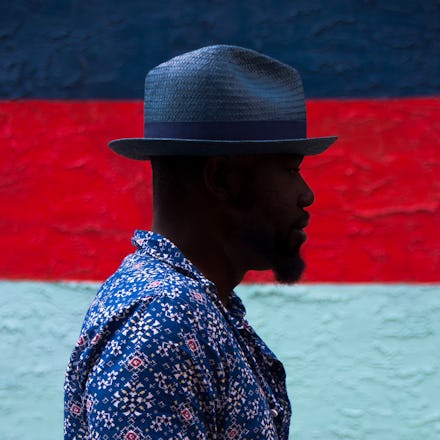Meet the Photographer Capturing America's Vibrant Black Neighborhoods as They Disappear

It's hard to tell exactly where Shawn Theodore's photographs are being taken.
The subjects that people his Instagram feed are often faceless. They hide in shadows or are outlined in silhouette, sitting, standing or moving across colorful backdrops — a painted concrete wall here, a sheet metal storefront there.
But most importantly, the individuals Theodore photographs are black. And their particular black struggle — one the photographer aims to capture each time he picks up a camera — helps illustrate the patterns he sees reshaping black America more broadly.
"I'd been reading about indigenous people being pushed out of their homes across the Americas," Theodore told Mic. "And I'm thinking, 'Wait a minute — that's happening in my neighborhood, that's happening right here."
Theodore confesses that his photos — which, because they don't feature landmarks or other such markers, assume a sort of universal quality — are taken mainly in cities along the mid-Atlantic stretch of I-95, the interstate highway that spans the eastern United States from New England to Florida.
"I live in Philadelphia, but I travel a lot to Baltimore and other places in between," he said. "New York City, Chester, Pennsylvania, Newark, Delaware. I'm looking to branch out further, to places like D.C., or Tennessee.
"But the idea is, you won't be able to tell. What's happening is part of this global, universal neighborhood."
The big push: New York might be the city that most visibly highlights what Theodore is talking about: the disappearance of formerly black spaces under the onslaught of gentrification.
From 2000 to 2010, the Brooklyn neighborhood of Bedford-Stuyvesant, for example, saw a 633% jump in its white population, while its black majority fell from 69% to 49% in the Bedford area, according to the New York Times. Since 2010, housing prices in North Brooklyn, of which Bed-Stuy is a part, have risen 65.6% — one of the largest jumps in one of the least affordable housing markets in the U.S., the Financial Times reports.
Theodore sees similar patterns engulfing much of the eastern seaboard. "I've been walking around doing street photography for about six years now," he explains. "I'm seeing these traditionally black neighborhoods being chopped away from the outside and inside. Real estate agencies, universities, just kicking people out.
"In my neighborhood," he adds, "I'm looking across the street at these new Lego-style houses getting thrown together. I'm literally going from facing the 'haves' to the 'have nots' by spinning around 180 degrees."
As such, Theodore's work is largely preservative. "I'm trying to capture a memory, but frame it in a way that future generations can respect."
To that end, his subjects are usually the individuals he meets in these neighborhoods. He prefers to photograph them in solitary, introspective moments — in sojourn with their vanishing environments, depicted in shadow not just to protect their privacy, but to symbolize their growing invisibility when faced with these larger, transformative forces.
But his work can also be activist in nature. "[Black people are] surrounded by so much hate in this country," he says. "I want people to have epiphanies when they look at these pictures ... to understand the communication of love without exploitation."
"Sometimes it takes just one image. Someone might say, 'This reminds me of my grandfather who passed away.' Or sometimes, since I'm doing candid shots, the pictures reunite people who hadn't seen each other in years. That's happened a good four or five times. You can't do that if you don't approach [the work] with love."
Considering how quickly these spaces are disappearing, love might soon be all we have left.
See more of Shawn Theodore's work on Instagram.